Artist Jim Webb of Studio 233 cuts his lamp bases from sheets of clay, then shapes them by hand.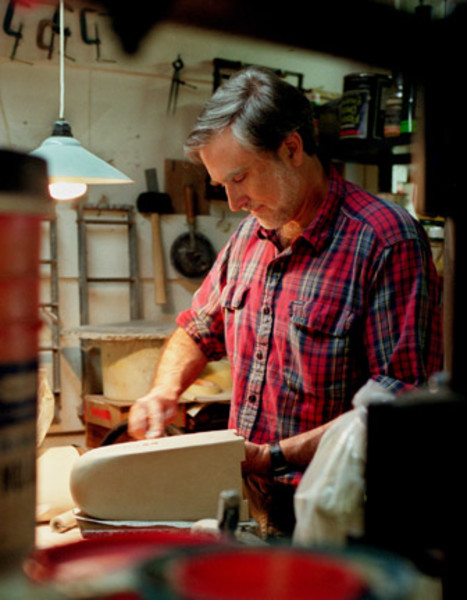
The Arts & Crafts movement in its original incarnation may have lasted just a scant few decades at the beginning of the 20th century, but, more than a hundred years later, the philosophies that spurred it continue to thrive. The evidence is all around, embodied in the vast number of artisans working today in the Arts & Crafts style. Creating everything from furniture to textiles to art glass, these modern-day craftsmen and -women have replicated and adapted the traditions of the past, adding a dose of their own imagination along the way to deliver a new generation of heirlooms. Nowhere is this renewed spirit of art and craft more pronounced than in the area of period lighting, where visionary artisans fuse polished wood, hammered metal, and fanciful art glass to bring time-honored Arts & Crafts forms back to life. Just as they did during the original movement, these lights run the gamut of period styles, from no-frills rectilinear lamps to chandeliers with intricate detailing inspired by nature.
Celadon lamp with mica shade, Studio 233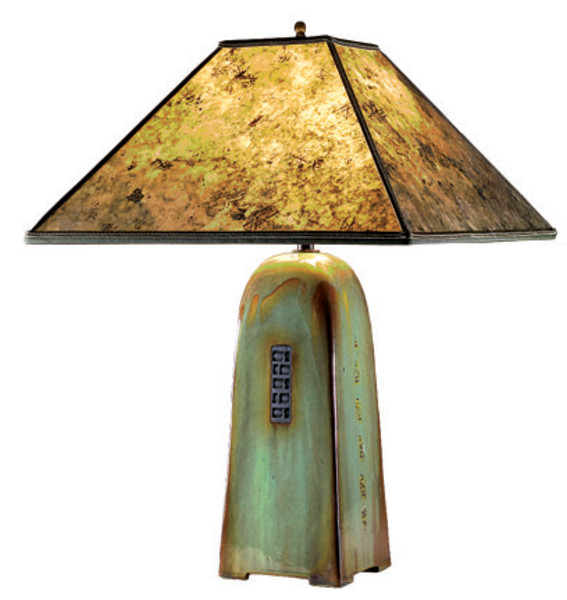
The Artisan: Jim Webb of Studio 233
His Craft: Although he holds a master’s degree in economics, ceramics have always been Webb’s passion; as an undergraduate at Princeton, he studied with renowned ceramic artist Toshiko Takaezu. When he opened his own studio in the late 1970s, he began by making ceramic tile, but soon switched his focus to lighting after collaborating with Berkeley-based lamp designer Sue Johnson, who still contributes the mica shades for his signature collection of lamps. (The lamps also are outfitted with paper shades, made by Webb’s wife, Barbara.) Webb’s hand-shaped, squared-off bases, each one incised with a geometric carving, are finished with a combination of glaze and metallic oxides to produce a richly toned, slightly burnished effect.
Gold Murrini Snail lamp, Phoenix Studios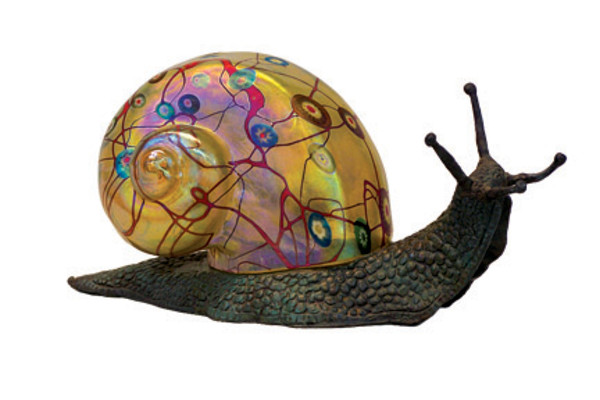
The Artisan: Carl Radke of Phoenix Studios
His Craft: In the 1970s, Radke was one of several young artists to rediscover the art of creating luster glass, a pearlescent form of art glass originally developed by Louis Comfort Tiffany, which peaked in popularity during the Art Nouveau and Arts & Crafts eras. The pearly sheen of the glass results from the interaction between silver and tin during the firing process, which Radke times carefully to ensure the ideal luster. He blows the glass into fanciful, nature-inspired lamps imprinted with images of blossoming trees and branches and bearing mushroom-like shades. (His most literal homage to nature, right, perches an iridescent luster shade atop the body of a snail.)
Tree chandelier, James Mattson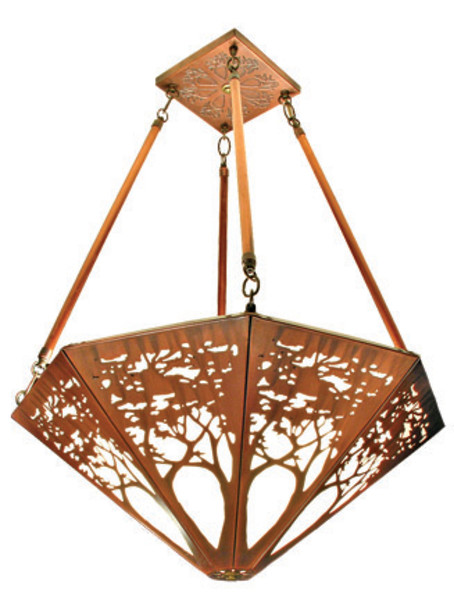
The Artisan: James Mattson
His Craft: Mattson was inspired to learn the art of copper etching after falling in love with a circa-1910 Limbert lamp made of copper, oak, and mica. With an old article from Popular Mechanics as a guide, he taught himself to hand-cut shapes from sheets of copper using traditional acid-etching techniques. He uses this method to create silhouette or bas relief designs in classic Arts & Crafts motifs, from leafy trees to iconic Dard Hunter roses. Mattson backs the silhouettes on his lamps, lanterns, sconces, and chandeliers with mica to create a trademark Arts & Crafts glow.
Fish shade on Leaves of Grass pottery base, Century Studios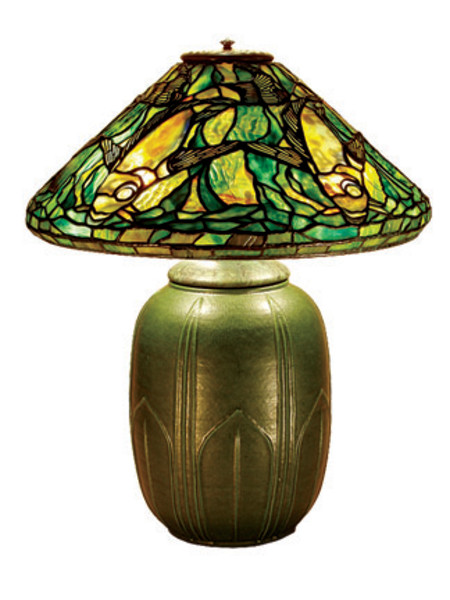
The Artisans: Irwin Terry and Bill Campbell of Century Studios
Their Craft: For more than a century, Louis Comfort Tiffany’s iconic stained-glass lamps have provided inspiration for countless reproductions—but none so faithful as those created by Century Studios. Artists Terry and Campbell (both graduates of the Minneapolis College of Art and Design) have thoroughly studied original Tiffany lamps produced between the 1890s and 1920s in order to re-create Tiffany’s designs in painstaking detail, using the same techniques Tiffany Studios employed at the turn of the century. Most of the stained-glass shades sit on bronze bases handcrafted by Century Studios using molds formed from original examples; others rest atop pottery bases created by Ephraim Faience, echoing Tiffany’s own occasional collaboration with noted Arts & Crafts potteries like Grueby and Rookwood.
Cathedral Feather tulip sconce, Pavonine Glass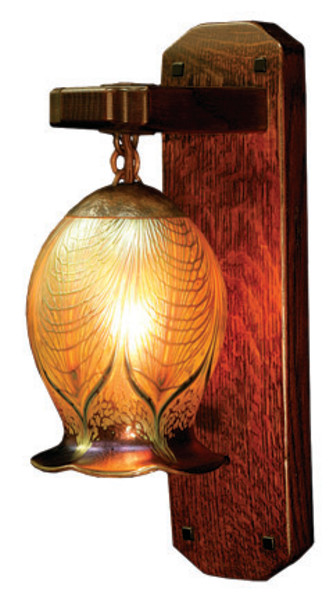
The Artisan: Evan Chambers of Pavonine Glass
His Craft: An accomplished glassblower (he caught the bug after watching a demonstration at Carl Radke’s studio), Chambers crafts Art Nouveau-style luster glass shades and lamp bases that boast an intricate, almost ethereal feathering. (The name of his company, Pavonine, refers to this peacock-like detailing.) To create the feathering, Chambers wraps different-colored bands of glass around the primary glass form before blowing, and then drags a pick through the molten-hot material to produce the distinctive designs. The shades are either hung from rustic copper chains, which Chambers also fabricates in his studio, or mounted as sconces on thick oak or mahogany frames designed by woodworker Ramon Ramirez.
Voysey Copper Leaf sconce, Christopher Vickers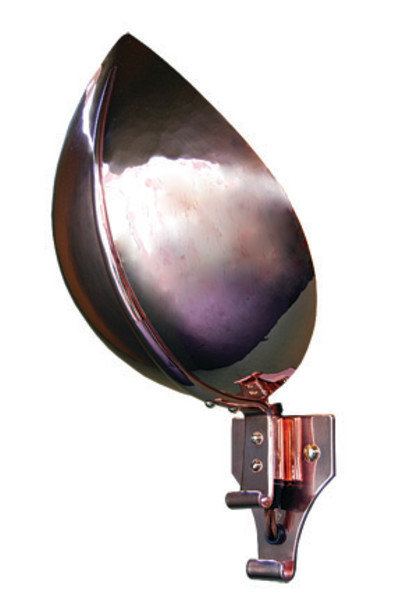
The Artisan: Christopher Vickers
His Craft: Unwaveringly devoted to the masters of the English Arts & Crafts movement, the UK-based Vickers has thoroughly researched the lighting designs of compatriots like C.F.A. Voysey, Ernest Gimson, and Norman Jewson. By studying the metalworking techniques of blacksmiths Alfred and Norman Bucknell (who hand-wrought pieces for both Gimson and Jewson), Vickers learned the traditional processes for creating organic forms from materials like repoussé copper and polished brass. With original drawings and examples as his guide, Vickers creates spot-on reproductions of these designers’ quirkier, lesser-known pieces, like a leaf-shaped copper Voysey sconce (right) created by the architect to adorn the picture rail of home he designed in Cumbria.
Handel base with olivine and serpentine shade, Julie Rauschenberger, (206) 938-9321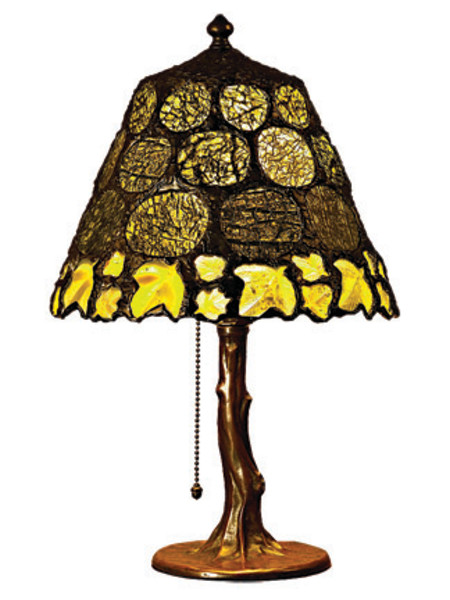
The Artisan: Julie Rauschenberger, (206) 938-9321
Her Craft: Take a look at the materials list for one of Rauschenberger’s handcrafted art glass lampshades, and you won’t find the usual suspects—instead, you’ll see items like Tanzanian ruby in zoisite, ocean jasper from Madagascar, or olivine from eastern Washington. Rauschenberger collects precious and semi-precious stones from every corner of the globe, slices and polishes them until they’re smooth and whisper-thin, then assembles the pieces using traditional stained-glass techniques. Although the shades are unconventional, the bases of the lamps will be familiar to Arts & Crafts aficionados—they’re all antiques from popular turn-of-the-century lighting manufacturers like Handel and Bradley & Hubbard, which lost their shades along the way.
Compass table lamp with ribbed shade, S.D. Murphy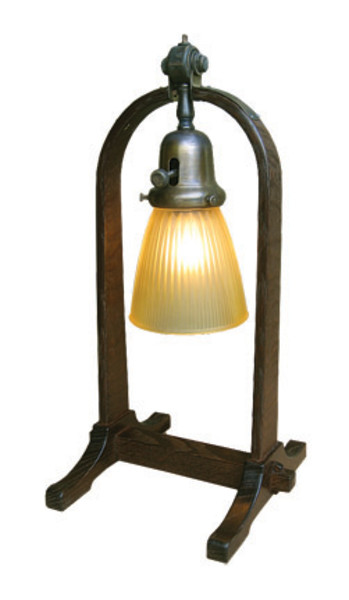
The Artisan: S.D. Murphy
His Craft: After dabbling in Arts & Crafts light- and furniture-making for years, Murphy was inspired to turn his hobby into a full-time profession after witnessing the enthusiastic response to his re-creation of Gustav Stickley’s Compass Lamp (below). A longtime fan of the clean, simple forms of Craftsman-style woodworking, Murphy takes the beloved designs of legendary furniture-makers like Stickley and Limbert and adapts them to today’s needs—for instance, using ribbed glass or mica shades on his Stickley reproductions in place of the potentially fire-hazardous silk-and-wicker ones on the originals. The lamps’ wood bases, however, are crafted of the same materials preferred by Arts & Crafts furniture-makers a century ago: rich-stained oak, cherry, and mahogany.







